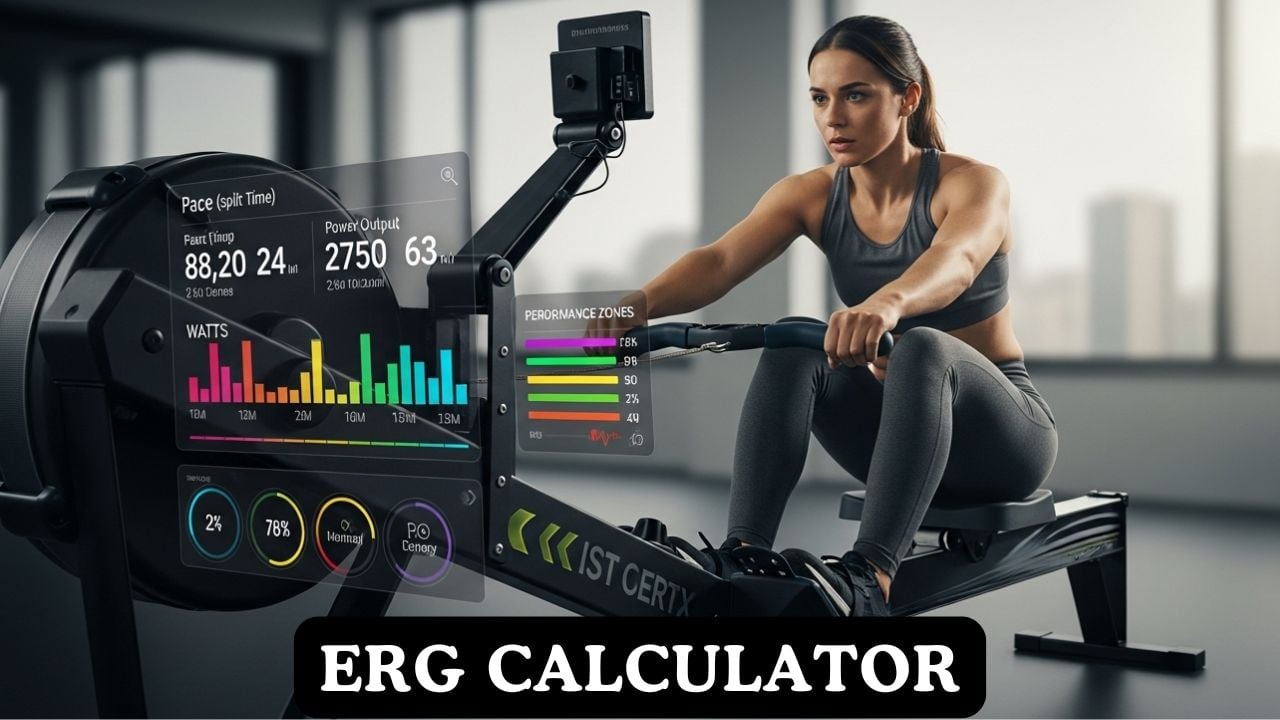ERG Calculator
Calculate your indoor rowing training zones, pace targets, and power output for optimal performance

What is an ERG Calculator?
An ERG calculator is a simple but powerful tool that helps you understand your indoor rowing performance and create better training plans. “ERG” stands for ergometer, which is the technical name for indoor rowing machines like the popular Concept2 rower. Regular rowing workouts provide excellent cardiovascular benefits and full-body strength training, making it one of the most effective exercises for overall fitness.
📊 How It Works
The ERG calculator takes your rowing test time (like a 2000m row) and converts it into different training zones. Think of it like having different gears on a bike – each zone serves a different purpose for your fitness. The calculator uses proven formulas to determine your pace (time per 500 meters) and power output (watts) for each training zone. This helps you row at the right intensity for your specific fitness goals, whether that’s losing weight, building endurance, or improving your rowing performance.
🎯 Why Use Training Zones?
Training zones prevent you from always rowing too hard or too easy. Many beginners make the mistake of going all-out every workout, which leads to burnout and poor results. Structured training with proper zones helps you build a strong aerobic base, improve your lactate threshold, and develop power when needed. It’s like having a personal trainer guiding your intensity for each workout session.
Understand Your Rowing Training Zones
💙 Recovery Zone (Very Easy)
This is your “easy conversation pace” where you could chat with a friend while rowing. Recovery zone workouts help your body repair and adapt to harder training sessions. Think of it as active rest – you’re moving and staying loose, but not stressing your system. Proper recovery is essential for long-term progress and injury prevention. Most of your weekly rowing volume should be in this comfortable zone.
🟢 Aerobic Zone (Easy to Moderate)
This is your “fat-burning zone” where your body efficiently uses oxygen to fuel your muscles. You’ll feel comfortably challenged but not breathless. Aerobic zone training builds your cardiovascular base and improves your body’s ability to use fat as fuel. It’s perfect for weight loss goals and building the endurance foundation that supports all other training. You can sustain this pace for 20-60 minutes.
🟡 Threshold Zone (Hard)
This is your “comfortably hard” pace – challenging but sustainable for 8-40 minutes. At threshold intensity, your body produces lactate at the same rate it clears it, creating a steady state. This zone improves your lactate threshold, which is crucial for racing and sustained hard efforts. Like strength training, threshold work requires focused effort and proper recovery between sessions.
🔴 Anaerobic Zone (Very Hard)
This is where you’re breathing hard and can only sustain the effort for 30 seconds to 8 minutes. Your body can’t supply oxygen fast enough, so it uses stored energy systems. Anaerobic training improves your VO2 max and power output. It’s like high-intensity leg workouts – very effective but requires adequate rest between intervals and should only be done 1-2 times per week.
⚡ Power Zone (Maximum)
This is your all-out, maximum effort pace that you can only maintain for 10-60 seconds. Power zone training develops neuromuscular coordination and peak power output. It’s like doing explosive push-ups – short bursts of maximum intensity. Use this zone sparingly for stroke rate practice and race starts, with full recovery between efforts.
How to Use the ERG Calculator
📝 Step-by-Step Instructions
Step 1: Choose your test distance. The 2000m test is most common and gives the most accurate results,
but you can use any distance from 500m to 10,000m.
Step 2: Enter your test time in minutes:seconds format (like 7:30 for 7 minutes and 30 seconds).
Step 3: Add optional information like age, weight, and experience level for more personalized results.
Step 4: Select your training goal to get customized zone recommendations.
Step 5: Click calculate to see your training zones, power output, and personalized recommendations.
🎯 Example Calculation
Sarah’s Example: 28-year-old intermediate rower, 65kg, completed 2000m in 8:30
Results:
• Base Pace: 2:07.5 per 500m
• Base Power: 185 watts
• Power-to-Weight: 2.85 W/kg
• Recovery Zone: 2:33 per 500m (122W)
• Aerobic Zone: 2:20 per 500m (154W)
• Threshold Zone: 2:07 per 500m (185W)
• Anaerobic Zone: 1:57 per 500m (224W)
• Power Zone: 1:48 per 500m (272W)
Training Plan: 70% aerobic, 20% recovery, 10% threshold work for endurance goals.
Indoor Rowing for Fitness and Weight Loss
🔥 Excellent Calorie Burner
Rowing is one of the most efficient exercises for burning calories because it uses both your upper and lower body simultaneously. A 150-pound person can burn approximately 300-400 calories in 30 minutes of moderate rowing. Unlike running, which primarily uses your legs, rowing engages about 85% of your muscle groups. For weight loss, focus on longer sessions in the aerobic and recovery zones rather than short, intense bursts.
💪 Full-Body Strength Training
Each rowing stroke works your legs, core, back, shoulders, and arms in a coordinated movement. It’s like doing back exercises, leg exercises, and core exercises all at once. The rowing motion builds functional strength that translates to better posture, reduced back pain, and improved daily movement patterns.
🦵 Low-Impact Joint-Friendly
Unlike running or jumping exercises, rowing is gentle on your joints while still providing an intense workout. The smooth, gliding motion reduces stress on your knees, hips, and ankles, making it perfect for people with joint concerns or those recovering from injuries. Regular low-impact exercise helps maintain joint health and mobility as you age.
Common ERG Training Questions
❓ How often should I test my rowing performance?
Test your rowing performance every 4-6 weeks to track progress and update your training zones. More frequent testing can interfere with training, while less frequent testing means your zones may become outdated. Choose a consistent distance (2000m is standard) and test under similar conditions each time. Avoid testing when you’re tired or haven’t warmed up properly, as this will give inaccurate results.
❓ What’s the difference between pace and power?
Pace (time per 500m) is easier to understand – it’s how fast you’re going. Power (watts) measures how much work you’re doing. Think of pace like your car’s speedometer and power like your engine’s horsepower. Power is more accurate for training because it accounts for stroke rate and efficiency. A beginner might row at 2:30 pace with poor technique using 150 watts, while an experienced rower maintains the same pace with better technique using only 130 watts.
❓ Can I use ERG training if I’m a beginner?
Absolutely! ERG training is perfect for beginners because it provides structure and prevents you from rowing too hard too often. Start with mostly recovery and aerobic zone work to build your base fitness. Like any new exercise routine, begin with shorter sessions (15-20 minutes) and gradually increase duration. Focus on proper technique before worrying about speed or power.
❓ How do I improve my rowing technique?
Good rowing technique starts with proper posture and sequence. The rowing stroke has four phases: catch, drive, finish, and recovery. Focus on using your legs first, then your back, then your arms on the drive. Keep your core engaged throughout the stroke. Strong core muscles are essential for efficient rowing. Consider taking a lesson or watching technique videos to avoid developing bad habits.
Building Your Rowing Training Plan
📅 Weekly Training Structure
Beginner Plan (3-4 days/week):
• 2 days aerobic zone (20-30 minutes)
• 1 day recovery zone (30-45 minutes)
• 1 day threshold work (10-15 minutes total)
Intermediate Plan (4-5 days/week):
• 3 days aerobic zone (30-45 minutes)
• 1 day recovery zone (45-60 minutes)
• 1 day threshold/anaerobic intervals
Advanced Plan (5-6 days/week):
• 3-4 days aerobic zone (45-75 minutes)
• 1 day recovery zone (60-90 minutes)
• 1-2 days high-intensity intervals
🎯 Training by Goals
Weight Loss Focus: Emphasize longer aerobic and recovery zone sessions.
Fat burning
occurs best during moderate-intensity, longer-duration exercise.
Endurance Building: Build your aerobic base with 70% of training in aerobic zone,
20% in recovery, and 10% at threshold.
Performance/Racing: Include all zones with emphasis on threshold and anaerobic work.
Combine rowing with strength training
for optimal results.
⚕️ Important Disclaimer
This ERG calculator provides training estimates based on established exercise science principles and should not replace professional coaching or medical advice. Individual responses to training vary significantly based on fitness level, health status, and other factors. The calculated zones are starting points that should be adjusted based on your perceived exertion and performance feedback. Consult with healthcare professionals before beginning any new exercise program, especially if you have pre-existing health conditions, injuries, or are taking medications. Always warm up before training and cool down afterward. Listen to your body and adjust intensity as needed to prevent injury and overtraining.
References
- Treff, G., Mentz, L., Mayer, B., Winkert, K., Engleder, T., & Steinacker, J. M. (2022). Initial Evaluation of the Concept-2 Rowing Ergometer’s Accuracy Using a Motorized Test Rig. Frontiers in Sports and Active Living, 3, 801617.
- Duterloo, Midas & Sluijs, Pauline & Kamphues, Jasmijn & Sim, Julia. (2021). THE ERGOMETER: A REPORT ON ERGOMETERS IN ROWING ASSOCIATIONS.
- Jones, J.A. & Allanson-Bailey, L. & Jones, Mike & Holt, Catherine. (2010). An Ergometer Based Study of the Role of the Upper Limbs in the Female Rowing Stroke. 10.1016/j.proeng.2010.04.031.

Manish is a NASM-certified fitness and nutrition coach with over 10 years of experience in weight lifting and fat loss fitness coaching. He specializes in gym-based training and has a lot of knowledge about exercise, lifting technique, biomechanics, and more.
Through “Fit Life Regime,” he generously shares the insights he’s gained over a decade in the field. His goal is to equip others with the knowledge to start their own fitness journey.
